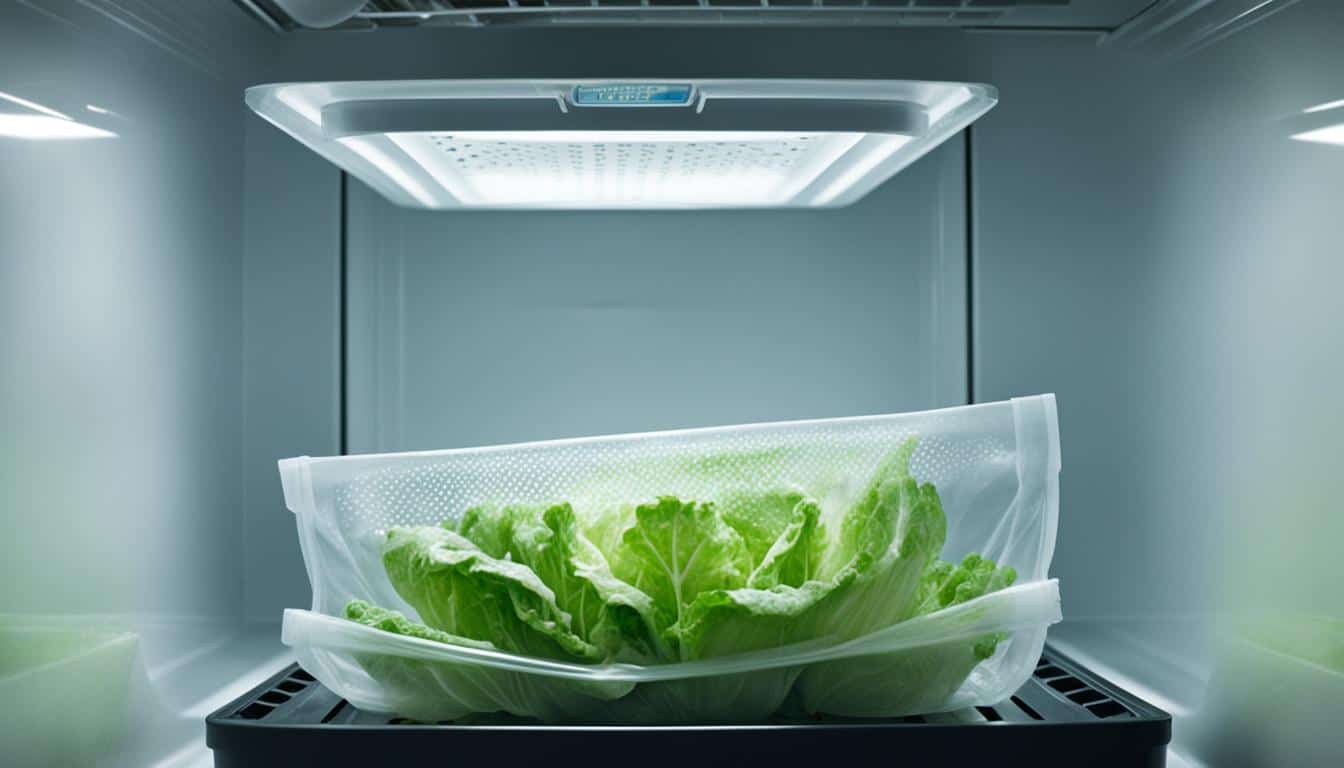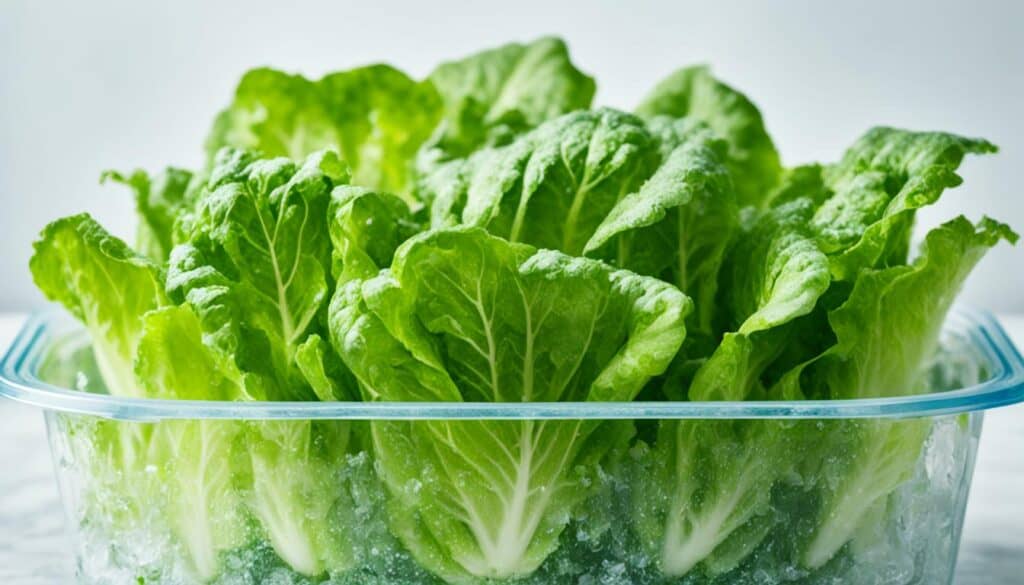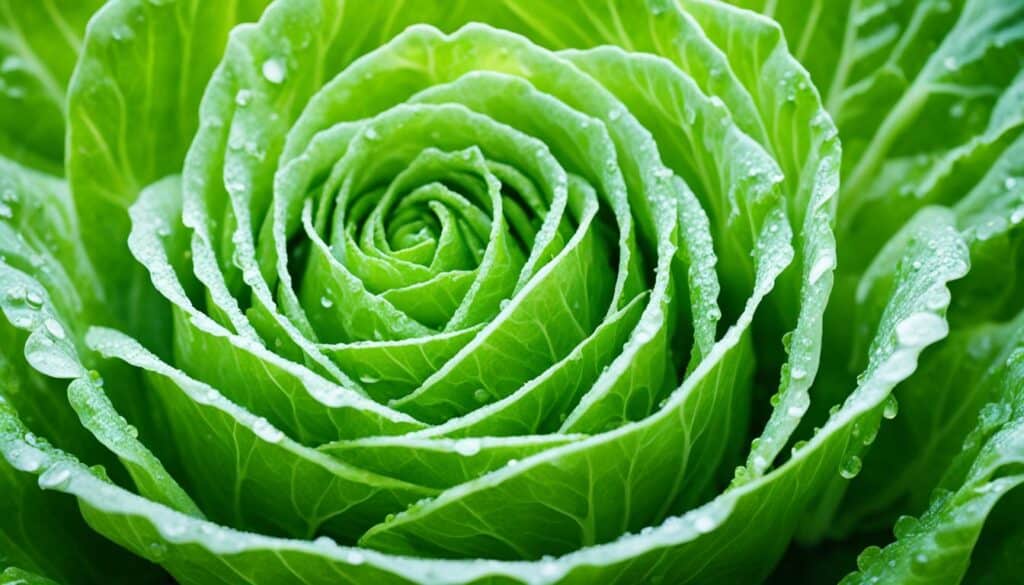Did you know that lettuce is one of the most widely consumed vegetables worldwide?
From refreshing Caesar salads to crunchy garden salads, lettuce heads play a starring role in our culinary endeavors. But to truly enjoy the vibrant flavors and nutritional benefits of lettuce, it’s essential to know how to select, store, and savor fresh lettuce heads.
In this article, I will share expert tips and techniques to extend the freshness of lettuce heads, including romaine and iceberg lettuce. With these tips, you can create crisp and nutritious salads that will leave your taste buds satisfied and your body nourished.
Key Takeaways:
- Knowing how to select a fresh lettuce head is crucial for crisp and flavorful salads.
- Proper storage techniques, such as using high humidity and avoiding ethylene-gas releasing fruits, can prolong the freshness of lettuce heads.
- There are various methods to extend the shelf life of lettuce heads, including wrapping them in kitchen towels or aluminum foil.
- Lettuce can also be frozen and used in recipes like casseroles or purees for soups and smoothies.
- Different lettuce varieties, such as iceberg, romaine, and loose-leaf lettuce, require specific storage methods for optimal freshness.
How to Choose and Inspect Fresh Lettuce Heads
https://www.youtube.com/watch?v=N2sGN38IJt4
When it comes to selecting the perfect fresh lettuce head for your salads, there are a few key qualities to look out for. Whether you’re buying iceberg lettuce or romaine lettuce, these tips will help you make the best choice and ensure your salads are bursting with freshness and flavor.
For iceberg lettuce, opt for heads that are tightly wrapped with crispy-edged leaves. Look for a fresh shade of light green, indicating optimal freshness. Avoid lettuce heads with wilted or brown-tipped leaves, as they may not provide the crisp texture you desire. A solid head that feels dense when handled is a good indicator of freshness. Additionally, steer clear of lettuce heads with any signs of wilting, discoloration, or mildew spots. Trust your nose too! A pleasant earthy fragrance is a sign of a fresh lettuce head.
When it comes to romaine lettuce, crispness is key. Look for leaves that are firmly bunched around the heart, ensuring a tight and compact head. Avoid lettuce heads with wilting, discolored leaves, or any signs of mildew. By choosing a lettuce head with these qualities, you can guarantee a satisfying crunch and vibrant taste in every salad.
I always recommend using your senses when selecting lettuce heads. Look for the visual cues of freshness, feel the density of the head, and take a whiff to ensure that earthy aroma. These simple tricks will help you choose the best lettuce heads for your culinary creations.
Compare and Contrast: Iceberg Lettuce vs. Romaine Lettuce
| Iceberg Lettuce | Romaine Lettuce |
|---|---|
| ✓ Tightly wrapped with crispy-edged leaves | ✓ Crisp leaves bunched around the heart |
| ✗ Avoid wilted or brown-tipped leaves | ✗ Avoid wilting, discolored leaves, or mildew spots |
| ✓ Fresh shade of light green | ✓ Pleasant earthy fragrance |
| ✗ Avoid wilting, discoloration, or mildew spots | ✗ Firm and solid head when handled |
A side-by-side comparison of iceberg lettuce and romaine lettuce can further clarify their key differences when selecting fresh lettuce heads. Take note of the unique qualities of each variety to ensure you’re making the right choice for your salads.
Now that you have a clear understanding of how to choose and inspect fresh lettuce heads, you can confidently buy lettuce heads that will elevate the taste and texture of your salads.
Proper Storage Techniques for Lettuce Heads
Storing lettuce heads correctly is crucial for maintaining their freshness. To help you keep your lettuce head crisp and flavorful, I’ve gathered some expert tips on how to store lettuce head properly.
Keep Lettuce in the Crisper Drawer
The crisper drawer in your fridge is the ideal spot to store lettuce heads. Set the humidity level to high to create the perfect environment. This will help prevent the lettuce from drying out and wilting.
Create a Lettuce-Only Zone
To maintain optimal freshness and prevent cross-contamination, designate one crisper drawer as a lettuce-only zone. This ensures that the lettuce remains undisturbed and avoids absorbing odors from other foods in your fridge.
Avoid Storing Near Ethylene-Releasing Fruits
Lettuce is sensitive to ethylene gas, which is released by certain fruits such as papayas and peaches. Avoid storing lettuce near these fruits to prevent it from ripening too quickly. This will help maintain its texture and flavor for longer.
Preservation Techniques for Extended Freshness
If you want to extend the freshness of your lettuce head, try these preservation techniques:
- Puffing the lettuce bag: Gently puffing air into the bag before sealing it can slow down the ripening process.
- Plastic containers layered with paper towels: Place delicate greens in a plastic container layered with paper towels. The towels will absorb any excess moisture and help keep the lettuce crisp.
By following these storage techniques, you can ensure that your lettuce heads stay fresh and flavorful for longer periods, allowing you to enjoy crisp and nutritious salads whenever you like.
Tips for Extending Lettuce Head Freshness
To keep your lettuce heads fresh and crisp for a longer period, I’ve got some simple tricks up my sleeve. Let’s dive right in!
- Dry and Wrap Shredded Lettuce: If you’ve already shredded your lettuce, no worries! Simply dry it thoroughly using a clean kitchen towel. After that, wrap it up in the towel and secure it with rubber bands. This technique can help you keep your shredded lettuce fresh for 2-3 days.
- Use Paper Towels and Plastic Bags: For whole lettuce heads, try this method. Take a few sheets of paper towels and layer them. Place the lettuce on top, then fold the paper towels over the lettuce to create a moisture-absorbing barrier. Carefully press out the air from a plastic bag and seal it. This packaging can extend the freshness of lettuce heads for up to 10 days.
- Preserve Romaine Lettuce with Aluminum Foil: Romaine lettuce fans, listen up! To keep your romaine lettuce crisps for an extended period, individually wrap each head tightly in aluminum foil. This little trick can retain the freshness of your romaine lettuce heads for up to a month. Impressive, right?
- Revive Wilting Lettuce with an Ice-Water Bath: Sometimes, lettuce can start to wilt after being stored for a while. Not to worry! Bring your lettuce back to life by giving it an ice-water bath. Just fill a bowl with ice-cold water, submerge the wilted lettuce, and let it soak for a few minutes. The cold water will help rehydrate the leaves, making them crisp and fresh again.
With these handy tips, you can ensure that your lettuce heads stay fresh, delicious, and ready to use whenever you need them. Now, let’s move on to the next section and explore how to freeze and use lettuce heads!
Freezing and Using Lettuce Head
Did you know fresh lettuce can be frozen for up to 6 months? Sturdy-leafed greens like romaine and butterhead are best for freezing. Here’s how you can freeze your lettuce head for future use:
- Wash and dry the lettuce head thoroughly.
- Separate the leaves from the core or stem.
- Place the lettuce leaves in airtight bags or containers to prevent freezer burn.
- Label the bags with the date to keep track of freshness.
- Store the lettuce in the freezer at 0°F (-18°C) or below.
When you’re ready to use the frozen lettuce, there are several ways to incorporate it into your recipes:
- Thawed lettuce works well in casseroles, stir-fries, soups, or as a substitute for spinach in dishes like lasagna or quiche.
- You can also puree fresh lettuce and freeze it in ice cube trays. Add these frozen lettuce cubes to soups, smoothies, or sauces for an extra boost of nutrition.
Get creative with your lettuce head and explore new recipes that highlight its versatility. Here are some ideas:
“Jalapeno and Cilantro Caesar Salad: A spicy twist on the classic Caesar salad, featuring crunchy lettuce leaves, zesty dressing, and a kick of jalapeno and cilantro.”
“Crunchy Apple and Romaine Wedges: A refreshing and healthy snack or side dish made with crisp lettuce wedges and sweet-tart apple slices.”
“Sweet and Hot Pork Lettuce Cups: An Asian-inspired dish that combines savory ground pork with a medley of vegetables, wrapped in lettuce cups for a flavorful and light meal.”
“Baby Iceberg Lettuce Stacks: Cute and convenient appetizers filled with delicious ingredients like cherry tomatoes, bacon, and blue cheese, layered between crisp baby iceberg lettuce leaves.”
| Benefits of Freezing Lettuce Head | Recipes to Try |
|---|---|
|
|
How to Store Iceberg Lettuce Head
Iceberg lettuce should be stored differently than other lettuce varieties. To keep iceberg lettuce fresh and crisp for longer, follow these simple steps:
- Keep the iceberg lettuce head intact and unwashed until you’re ready to use it. This helps maintain its freshness and prevents wilting.
- Wrap the iceberg lettuce head tightly in plastic, ensuring it is completely sealed. This helps preserve its crispness and prevents exposure to air, which can cause the lettuce to spoil faster.
- Regular iceberg lettuce heads can last 10-12 days in the refrigerator when stored properly.
- Consider using perforated plastic bags for baby iceberg lettuce heads. These bags provide optimal airflow, allowing the lettuce to breathe and stay fresh for up to a week.
- If you’re looking for restaurant-quality storage, consider purchasing restaurant-grade perforated bags for your iceberg lettuce. These bags are specifically designed to maintain freshness and extend the shelf life of the lettuce.
By following these storage tips, you can enjoy crisp and refreshing iceberg lettuce in your salads or sandwiches for longer periods of time.
How to Store Romaine Lettuce Head
When it comes to storing romaine lettuce heads, there are a few key steps to ensure freshness and longevity. Whether you prefer to wash your romaine before storing or keep it unwashed for convenience, here’s how to keep romaine lettuce fresh:
- Start by separating the leaves from the heart. This allows for better airflow and helps prevent moisture buildup.
- Take a moment to inspect the leaves and remove any wilted or damaged ones. This helps maintain the overall quality of the lettuce.
- Next, pat the romaine leaves dry using a clean kitchen towel or paper towels. Excess moisture can lead to premature spoilage.
- Once the leaves are dry, tightly seal them in a plastic bag. Squeeze out any excess air before sealing to create a snug environment for the lettuce.
- Store the sealed bag of romaine lettuce in the crisper drawer of your refrigerator. This helps maintain a consistent temperature and humidity level.
By following these steps, you can maximize the shelf life of romaine lettuce. Whole romaine heads can last anywhere from 10 to 20 days when stored properly, while romaine hearts (just the leaves without the outer layers) typically stay crisp for about a week to 10 days. Remember to check the lettuce periodically for any signs of spoilage, and remove any compromised leaves to maintain the freshness of the remaining leaves.
Tips for Using Stored Romaine Lettuce
Stored romaine lettuce can be used in a variety of recipes. Whether you’re making a classic Caesar salad, wrapping up flavorful lettuce wraps, or adding crispness to a sandwich, here are some tasty suggestions:
- Create a refreshing and satisfying Mediterranean-inspired salad with romaine lettuce, cherry tomatoes, cucumber slices, olives, feta cheese, and a tangy vinaigrette.
- Add chopped romaine lettuce to your favorite stir-fry for a vibrant crunch.
- Make a hearty and healthy wrap by filling a romaine lettuce leaf with grilled chicken, avocado, and your choice of condiments.
- Blend chopped romaine lettuce into your morning smoothie for an extra dose of vitamins and fiber.
With these simple storage techniques and flavorful recipe ideas, you can enjoy the crispness and nutritional benefits of romaine lettuce for longer.
How to Store Loose Leaf Lettuce Head
Loose leaf lettuce is a convenient option for salads, but it requires extra care to ensure its freshness. To keep your loose leaf lettuce crisp and flavorful, follow these simple steps:
- Wash and pat dry: Start by washing the lettuce leaves thoroughly to remove any dirt or contaminants. After washing, gently pat the leaves dry with paper towels to remove excess moisture.
- Optimal storage container: Place the lettuce back in its original container or use a sturdy glass or plastic container. Make sure to line the container with paper towels to help control moisture and promote air circulation.
- Proper storage: Seal the container tightly and store it in the refrigerator. The cool temperature will help maintain the freshness of the loose leaf lettuce.
Avoid storing loose leaf lettuce for too long, as it tends to wilt more quickly compared to other lettuce varieties. Typically, loose leaf lettuce stays fresh for around 3-5 days when stored properly.
To speed up the drying process after washing the lettuce, consider using a salad spinner. This handy tool quickly removes excess water, allowing you to store the lettuce head without excess moisture.
Remember, fresh lettuce is the key to a delicious salad, so follow these steps to keep your loose leaf lettuce head fresh and ready to enjoy!
| Storage Tips for Loose Leaf Lettuce Head | |
|---|---|
| 1. Wash and pat dry the lettuce leaves. | |
| 2. Use a sturdy container lined with paper towels. | |
| 3. Seal the container tightly. | |
| 4. Store in the refrigerator. | |
| 5. Use within 3-5 days for optimal freshness. |
Conclusion
With the tips and techniques shared in this article, you can confidently select, store, and enjoy fresh lettuce heads for your healthy salads. Paying attention to the quality and freshness of the lettuce head is key to creating vibrant, flavorful salads that are packed with nutrients.
By following proper storage methods, such as storing lettuce heads in the crisper drawer with high humidity and keeping them away from ethylene-producing fruits, you can extend the freshness of lettuce heads and prevent them from wilting or becoming discolored.
Don’t be afraid to get creative with recipes and explore the versatility of lettuce in your kitchen. Whether you’re making a classic Caesar salad or trying out a new lettuce cup recipe, the crispness and freshness of lettuce head will elevate your dishes and provide a satisfying crunch.
Remember to support trusted growers like Hitchcock Farms for the freshest leafy greens. Their commitment to quality ensures that you’ll always have access to the best lettuce head for your salads. So go ahead, enjoy crisp and vibrant salads all year round!









Leave a Reply